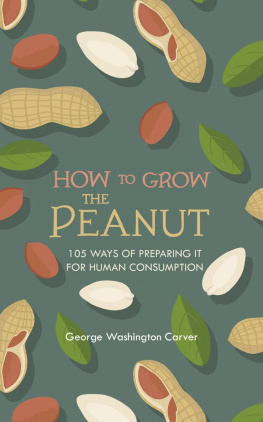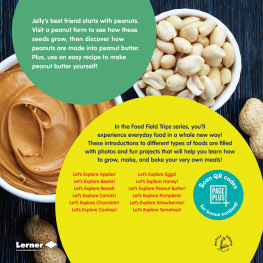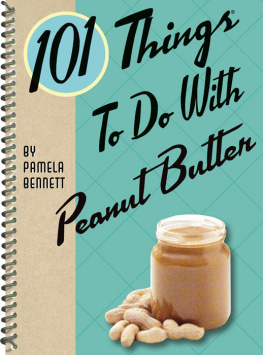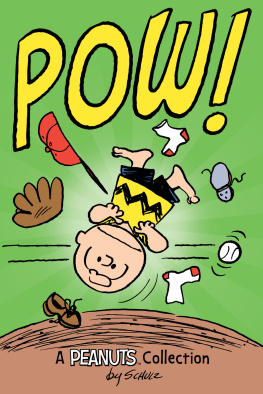HOW TO GROW THE PEANUT
And 105 Ways of Preparing It for Human Consumption
GEORGE W. CARVER
Published by Left of Brain Books

Copyright 2021 Left of Brain Books
ISBN 978-1-396-31815-3
eBook Edition
All rights reserved. No part of this publication may be reproduced, distributed, or transmitted in any form or by any means, including photocopying, recording, or other electronic or mechanical methods, without the prior written permission of the publisher, except in the case of brief quotations embodied in critical reviews and certain other noncommercial uses permitted by copyright law. Left of Brain Books is a division of Left of Brain Onboarding Pty Ltd.
Table of Contents
How to Grow the Peanut and 105 Ways of Preparing It for Human Consumption
Of all the money crops grown by Macon County farmers, perhaps there are none more promising than the peanut in its several varieties and their almost limitless possibilities.
Of the many good things in their favor, the following stand out as most prominent:
1. Like all other members of the pod-bearing family, they enrich the soil.
2. They are easily and cheaply grown.
3. For man the nuts possess a wider range of food values than any other legume.
4. The nutritive value of the hay as a stock food compares favorably with that of the cow pea.
5. They are easy to plant, easy to grow and easy to harvest.
6. The great food-and-forage value of the peanut will increase in proportion to the rapidity with which we make it a real study. This will increase consumption, and therefore, must increase production.
7. In this county two crops per year of the Spanish variety can be raised.
8. The peanut exerts a dietetic or a medicinal effect upon the human system that is very desirable.
9. I doubt if there is another foodstuff that can be so universally eaten, in some form, by every individual.
10. Pork fattened from peanuts and hardened off with a little corn just before killing, is almost if not quite equal to the famous Red-gravy hams or the world renowned Beech-nut breakfast bacon.
11. The nuts yield a high percentage of oil of superior quality.
12. The clean cake, after the oil has been removed, is very high in muscle-building properties (protein), and the ease with which the meal blends in with flour, meal, etc., makes it of especial value to bakers, confectioners, candy-makers, and ice cream factories.
13. Peanut oil is one of the best known vegetable oils.
14. A pound of peanuts contains a little more of the body-building nutrients than a pound of sirloin steak, while of the heat and energy-producing nutrients it has more than twice as much.
Varieties
There are many varieties of the peanut, all possessing more or less merit. A number have been tested here on our Station grounds and we can heartily recommend the following varieties in the order named:
1st, The Spanish.As compared with most other varieties the vines are small, upright in growth, with nearly all the pods clinging close to the tap-root; hence, they can be planted closer together and the yield will be larger.
This variety produced 59 bushels per acre on very light, sandy soil.
2nd, The Georgia and Tennessee Red.These are practically one and the same varietyhabit of growth and fruiting qualities are much the same as the Spanishwith us it made a slightly lower yield.
This variety has from three to four kernals to the pod. The nuts are rich in flavor.
3rd, The Virginia Running Variety.This variety is often referred to as the typical American peanut. It is decidedly the most popular with the trade. The pods are large and white, the vines spreading, and under favorable conditions it fruits nearly out to the ends of the branches.
Soil
With reference to soil there are two things, to bear in mind; viz., whether they are for market or home consumption.
The trade demands a light-colored shell, which is only produced on light, sandy, porous soil.
More bushels per acre can be grown on stiff, clayey soil than upon light soil, but the pods will be stained dark. In fact any land that will produce good corn will produce good peanuts provided there is plenty of lime in it.
Preparation
In the preparation of the soil the chief essentials are
1. Deep plowing, from 8 to 9 inches.
2. Thorough pulverization with a harrow, drag, smoothing board, etc.
3. Remove all stones, roots, stumps, clods, and obstructions of all kinds.
Fertilizers for Peanuts
The peanut is an interesting plant, in that it adjusts itself to many kinds and methods of fertilization. It does well fertilized exactly as for corn; makes a splendid yield when given the same treatment as cow peas; does equally well when fertilized the same as for cotton.
For the sandy soils of Macon County we found the following compost mixture most satisfactory:
In the fall and winter a large pen was filled with leavesmuck from the swampand farmyard manure. The mixture consisted of one load of leaves from the woods together with the rich top earth, one load of muck from the swamp, and one load of manure from the barns, pig-pen, poultry house, etc. The pen was filled in this way, a rough shed put over it to throw off the excess of water, so the fertility would not be washed out. Eighteen tons of this mixture, together with 100 lbs. acid phosphate, 50 lbs. kainit, and 200 lbs. lime, were applied to the acre.
Where one must depend upon a commercial mixture the one given below gave decidedly the largest yield:
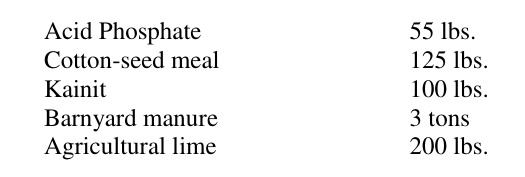
Note.On soils containing lime, do not add any to the fertilizer mixture.
Planting
The time for planting the peanut in this locality is practically the same as for corn, beginning about the middle of March when not hulled, and the first of April when shelled. A good plan is to break the shell crosswise; they come up almost as quickly as when shelled.
If the Spanish peanut is shelled and planted early in April, it will mature about the middle of July, when they can be pulled, the ground prepared again, reseeded, and a second crop produced.
There are two principal methods of planting the peanut; viz., in drills and checks. The drill method proved most desirable with us, giving the largest yield.
For the Spanish we placed our rows from 2 to 3 feet apart; for the running varieties, from 3 to 3 feet apart. Furrows were run as nearly 4 inches deep as possible, the compost; put directly into the furrow, and the nuts planted on it.
Cultivation
If the land has been well prepared as above directed and is practically free from weed seeds, the cultivation will be quite simple. Cultivate only enough to keep the ground soft and mellow and free from weeds.
There are two methods, however, of cultivating the peanut; viz., the ridge method, and the flat method. We tried both, and the flat method gave decidedly the best results.
Harvesting
The time to harvest varies with the date of planting and the variety of peanut. Experienced planters prefer to get their crop harvested before the first killing frost, because it not only injures some of the nuts, but greatly damage the hay, by lowering its feeding value and causing the vines to drop their leaves.
There are a number of special plows and devices made to render harvesting of the crop as easy as possible. All of them have more or less merit. The small farmer, however, can use to good advantage the same method used in harvesting the sweet potato; viz., that of plowing a furrow on each side of the vines, and then bursting out the middle containing the vines, which can be picked up readily, the earth shaken off and the vines wind-rowed, loosely piled, or treated in any way desired. An old and favorite way is to plow up the vines in the morning of a warm, sunshiny day, allowing them to dry until late in the afternoon, when they are gathered up and stacked around poles, which are about 7 feet high, and set firmly in the ground at convenient places over the field.
Next page
